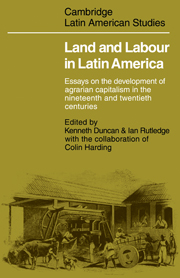 Land and Labour in Latin America
Land and Labour in Latin America Published online by Cambridge University Press: 07 May 2010
In northern Mexico, where population was sparse and land plentiful, large estates predominated; their size, roughly speaking, increased with aridity and distance from Mexico City. In the state of San Luis Potosi, situated in what might be called the middle north, haciendas covered an average area of about fifteen square leagues; that is, between 25,000 and 30,000 hectares each. The few Indian villages that existed – there had been no sedentary population in northern Mexico before the Conquest – were also well endowed with land, some of them originally having been granted some thirty-six square leagues each by the colonial government. Estates naturally made frequent inroads into these communal holdings, thereby expanding at the expense of the Indian villages. The opposite process also took place occasionally, at least after Mexico became independent in 1821.
The population of the old-established Indian villages was not very large, and it would seem that in the early nineteenth century they did not supply the haciendas with much of the required seasonal labour; instead the estates had to rely almost entirely on their own permanent labourers. Another source of seasonal labour arose in time, eventually replacing the old villages. The estates were enormous, and in the beginning only the land around the casco – the farm buildings – was cultivated, and the rest was given over to extensive cattle-grazing. The peones or farm labourers lived in the casco, leaving the rest of the estate virtually uninhabited, except for a few small, scattered ranches where the cattle herds were kept and where the herders lived.
To save this book to your Kindle, first ensure [email protected] is added to your Approved Personal Document E-mail List under your Personal Document Settings on the Manage Your Content and Devices page of your Amazon account. Then enter the ‘name’ part of your Kindle email address below. Find out more about saving to your Kindle.
Note you can select to save to either the @free.kindle.com or @kindle.com variations. ‘@free.kindle.com’ emails are free but can only be saved to your device when it is connected to wi-fi. ‘@kindle.com’ emails can be delivered even when you are not connected to wi-fi, but note that service fees apply.
Find out more about the Kindle Personal Document Service.
To save content items to your account, please confirm that you agree to abide by our usage policies. If this is the first time you use this feature, you will be asked to authorise Cambridge Core to connect with your account. Find out more about saving content to Dropbox.
To save content items to your account, please confirm that you agree to abide by our usage policies. If this is the first time you use this feature, you will be asked to authorise Cambridge Core to connect with your account. Find out more about saving content to Google Drive.